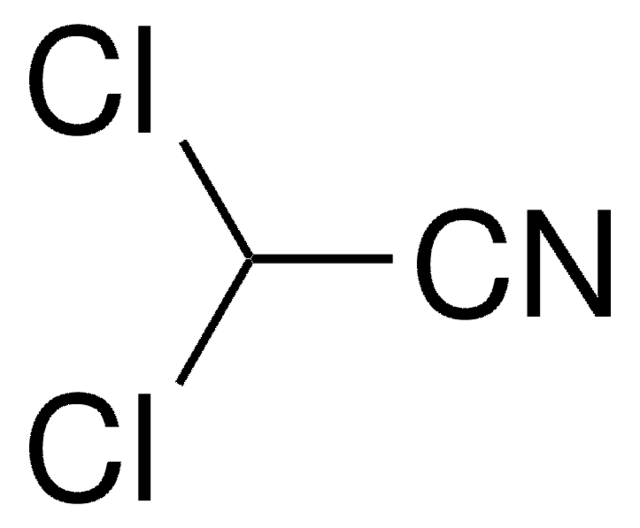139181
Bromodichloromethane
≥97%
Synonym(s):
Dichlorobromomethane
Sign Into View Organizational & Contract Pricing
All Photos(2)
About This Item
Linear Formula:
BrCHCl2
CAS Number:
Molecular Weight:
163.83
Beilstein:
1697005
EC Number:
MDL number:
UNSPSC Code:
12352100
PubChem Substance ID:
NACRES:
NA.22
Recommended Products
Assay
≥97%
form
liquid
contains
potassium carbonate as stabilizer
refractive index
n20/D 1.497 (lit.)
bp
87 °C (lit.)
mp
−55 °C (lit.)
solubility
water: insoluble
density
1.98 g/mL at 25 °C (lit.)
functional group
bromo
SMILES string
ClC(Cl)Br
InChI
1S/CHBrCl2/c2-1(3)4/h1H
InChI key
FMWLUWPQPKEARP-UHFFFAOYSA-N
Looking for similar products? Visit Product Comparison Guide
Application
Bromodichloromethane was used to investigate the in vivo genotoxicity of chlorodibromomethane, bromodichloromethane and bromoform in mice.
Biochem/physiol Actions
Bromodichloromethane (BDCM) induces steatohepatitic injury in human liver. BDCM induces the cell proliferation in different tissues and kidney damage by renal tuble cell proliferation in male F344 rats.
Signal Word
Danger
Hazard Statements
Precautionary Statements
Hazard Classifications
Acute Tox. 4 Oral - Carc. 2 - Eye Dam. 1 - Skin Irrit. 2 - STOT SE 3
Target Organs
Respiratory system
Storage Class Code
10 - Combustible liquids
WGK
WGK 3
Flash Point(F)
Not applicable
Flash Point(C)
Not applicable
Personal Protective Equipment
dust mask type N95 (US), Eyeshields, Gloves
Choose from one of the most recent versions:
Already Own This Product?
Find documentation for the products that you have recently purchased in the Document Library.
Customers Also Viewed
K J Stocker et al.
Mutagenesis, 12(3), 169-173 (1997-05-01)
Chlorination of drinking water results in the formation of chlorodibromomethane, bromodichloromethane and bromoform. These trihalomethanes have all shown evidence of genotoxicity in bacterial and mammalian cell systems in vitro and some evidence of carcinogenicity in rodents. Chlorodibromomethane and bromodichloromethane have
Suvarthi Das et al.
American journal of physiology. Gastrointestinal and liver physiology, 305(12), G950-G963 (2013-10-26)
Recent studies indicate that metabolic oxidative stress, autophagy, and inflammation are hallmarks of nonalcoholic steatohepatitis (NASH) progression. However, the molecular mechanisms that link these important events in NASH remain unclear. In this study, we investigated the mechanistic role of purinergic
Ted Lock et al.
Archives of toxicology, 78(7), 410-417 (2004-05-14)
Male F344 rats exposed to bromodichloromethane (BDCM) by gavage at 50 or 100 mg/kg/day for 5 days a week for 28 days excreted large amounts of formic acid in their urine, which was accompanied by a change in urinary pH.
Regina Grazuleviciene et al.
Occupational and environmental medicine, 70(4), 274-282 (2013-02-14)
Congenital anomalies have been inconsistently associated with maternal crude estimated exposure to drinking water trihalomethane (THM). We investigated the relationship between individual THM uptake during the first trimester of pregnancy and congenital anomalies. We estimated maternal THM uptake for 3074
Teresa L Leavens et al.
Toxicological sciences : an official journal of the Society of Toxicology, 99(2), 432-445 (2007-07-28)
Exposure to bromodichloromethane (BDCM), one of the most prevalent disinfection byproducts in drinking water, can occur via ingestion of water and by dermal absorption and inhalation during activities such as bathing and showering. The objectives of this research were to
Our team of scientists has experience in all areas of research including Life Science, Material Science, Chemical Synthesis, Chromatography, Analytical and many others.
Contact Technical Service









